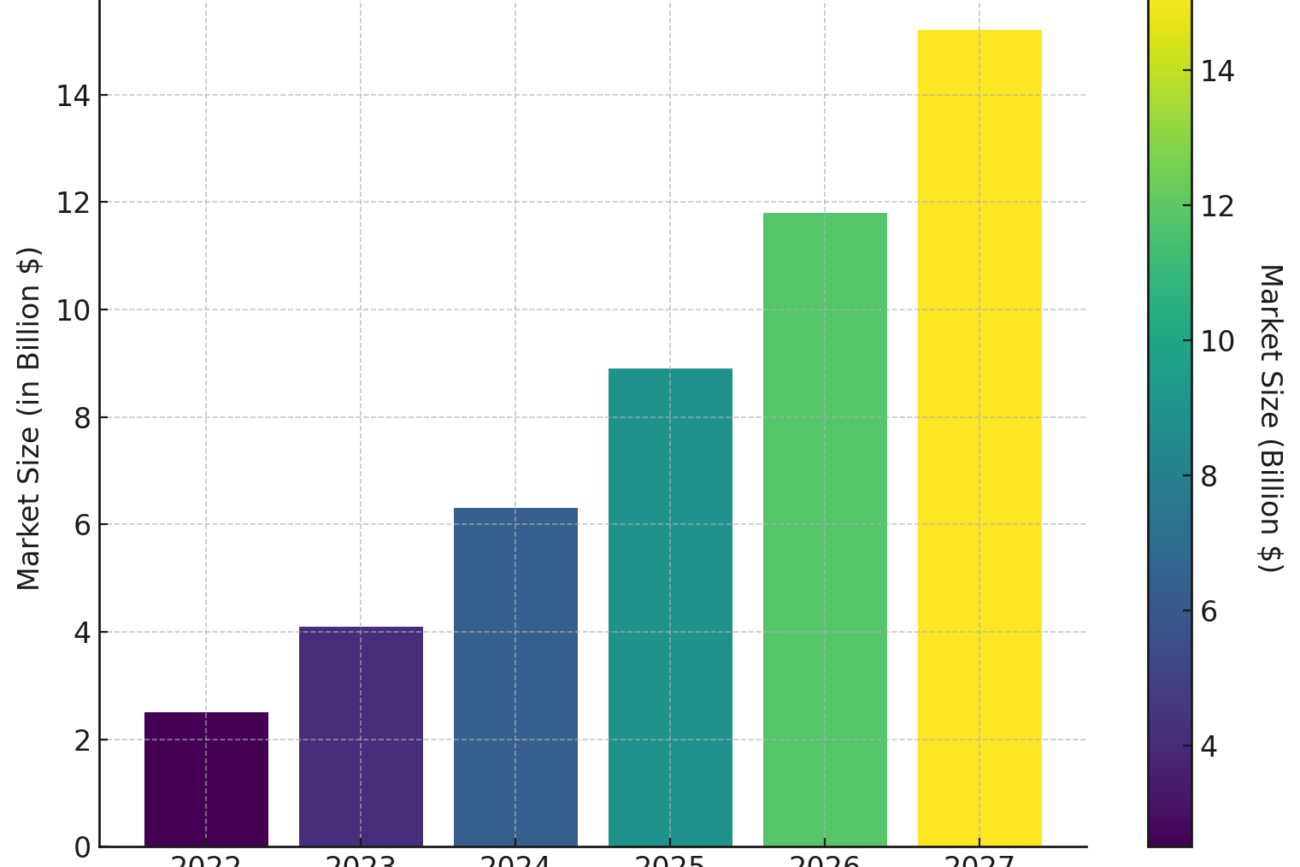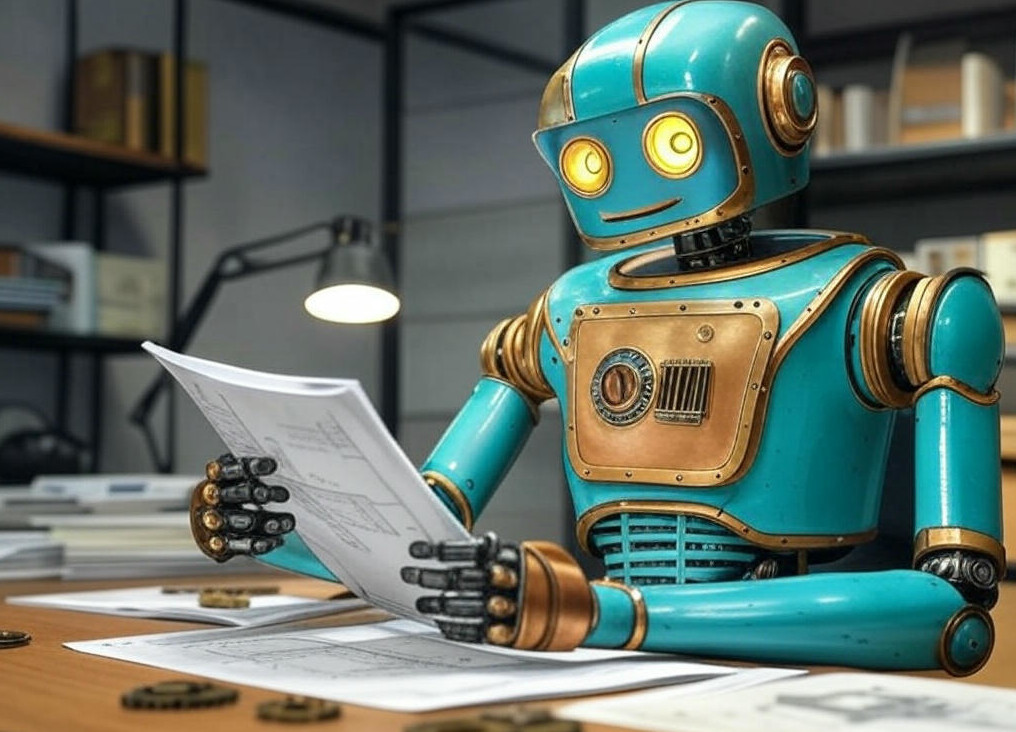What Is AI Agent as a Service?

AI Agent as a Service (AaaS) is transforming how businesses operate, making AI-driven automation more accessible and cost-effective. But what exactly is AI Agent as a Service, and how can it benefit your business?
Imagine hiring an employee who works 24/7, never takes a coffee break, and learns new skills instantly. That’s AI Agent as a Service in a nutshell—an intelligent, digital workforce designed to handle repetitive tasks, customer interactions, and data-driven processes efficiently.
In this article, we’ll break down AI Agent as a Service in simple terms, explore its benefits, and showcase data-driven insights to help you decide if it’s the right solution for your business.
What Is AI Agent as a Service?
AI Agent as a Service (AaaS) is a cloud-based, AI-driven service that enables businesses to automate tasks traditionally performed by humans. Instead of hiring employees for repetitive or time-consuming jobs, companies can use AI-powered agents to handle customer service, data processing, scheduling, and other operational functions efficiently.
A Simple Analogy: AI Agent as a Service as a Digital Employee
Think of AI Agent as a Service as hiring an employee who:
- Never sleeps – Works 24/7 without breaks.
- Learns instantly – Absorbs new skills and updates automatically.
- Doesn’t need an office – Operates entirely in the cloud.
- Costs a fraction of a salary – Subscription-based, no payroll taxes or benefits.
These AI-powered agents can be seamlessly integrated into a company’s workflows, reducing human workload and increasing operational efficiency.
AI Agent as a Service in Action: Everyday Use Cases
AI Agent as a Service is already being used across various industries. Here are a few real-world examples:
- Retail: AI-powered chatbots handle customer inquiries, reducing response times.
- Finance: AI-driven fraud detection systems identify fraudulent transactions in real-time.
- Healthcare: Virtual assistants schedule patient appointments and send reminders.
- E-commerce: Automated AI agents recommend products based on user behavior and purchasing trends.
How Agent as a Service Compares to Traditional Employees
| Feature | AaaS (Agent as a Service) | Traditional Employee |
|---|---|---|
| Availability | 24/7, no downtime | Limited to work hours |
| Scalability | Instantly adjustable | Requires hiring & training |
| Learning Speed | Learns instantly from data | Requires training & experience |
| Cost | Subscription-based, predictable | Salary, benefits, taxes |
| Error Rate | Low with AI-driven precision | Higher due to human error |
AI Agent as a Service isn’t just an emerging technology—it’s already driving measurable results across industries. But how does it actually work? Let’s break it down in the next section.
Did You Know?
According to a 2024 report by McKinsey, businesses implementing AI-driven automation see a 30% reduction in operational costs and a 40% increase in productivity.
How AaaS Works
AI Agent as a Service (AaaS) functions as a digital workforce, automating repetitive tasks, processing data, and making intelligent decisions—all without human supervision. These AI-powered agents streamline operations, reduce costs, and enhance customer experiences.
Step-by-Step Process: How AI Agent as a Service Operates
| Stage | Description |
|---|---|
| 1. Data Collection | The AI agent gathers information from sources like emails, CRM systems, chatbots, and databases. |
| 2. Processing & Decision-Making | The agent analyzes data and determines the optimal action using AI and machine learning. |
| 3. Task Execution | The AI agent performs the required task—whether responding to a customer query, updating a system, or executing a financial transaction. |
| 4. Continuous Learning & Optimization | Over time, the agent improves accuracy and efficiency by learning from interactions. |
AaaS in Action: Industries & Use Cases
AaaS is revolutionizing multiple industries. Below is a breakdown of where it’s making the biggest impact:
| Industry | Example of AaaS Implementation | Efficiency Gain |
|---|---|---|
| Retail | AI chatbots handling 80% of customer inquiries | 50% faster response times |
| Finance | AI-driven fraud detection in real-time | 40% reduction in fraud cases |
| Healthcare | Virtual assistants managing patient appointments | 30% reduction in missed appointments |
| E-commerce | AI-powered recommendation engines increasing sales | 25% boost in conversion rates |
| HR & Recruiting | AI screening resumes and scheduling interviews | 60% reduction in hiring time |
AaaS as an Automated Factory
Think of AaaS as a factory conveyor belt for digital tasks:
- Instead of humans manually performing each step, AI-driven agents automate the workflow.
- Information flows seamlessly from one stage to the next, reducing delays and human errors.
- Over time, the system optimizes itself, much like an efficiently running assembly line.
Market Growth of AaaS (Chart)
The adoption of AaaS has been rapidly increasing over the past few years. Below is a projected growth chart for the AaaS market:
Global AaaS Market Growth (2022-2027)

Projected AaaS Market Growth
(Source: Statista, 2024)
Key Technologies Powering AI Agent as a Service
AaaS relies on a combination of advanced technologies to function effectively:
- Artificial Intelligence (AI): Enables automation and decision-making.
- Machine Learning (ML): Allows agents to improve over time based on data patterns.
- Natural Language Processing (NLP): Enables AI to comprehend and produce human-like text.
- Robotic Process Automation (RPA): Automates repetitive tasks such as data entry and processing.
AaaS Adoption Rate by Business Size (2023-2025)
| Business Type | Adoption Rate in 2023 | Projected Adoption in 2025 |
|---|---|---|
| Large Enterprises | 65% | 85% |
| Mid-Sized Companies | 40% | 65% |
| Small Businesses | 20% | 50% |
📈 Trend Insight:
- Large enterprises are leading AI Agent as a Service adoption due to scalability needs.
- Small businesses are expected to double adoption rates as costs decrease.
Did You Know?
A 2023 Gartner report predicts that by 2026, over 50% of all customer service inquiries will be handled by AI-powered agents, up from just 15% in 2022.
Key Benefits of AI Agent as a Service

AI Agent as a Service (AaaS) is transforming business operations by reducing costs, increasing efficiency, and improving customer experiences. Whether you’re a small business owner or leading a large enterprise, AaaS provides a scalable, cost-effective solution that enhances productivity and streamlines workflows.
Below, we explore the key benefits of AaaS with supporting data, real-world applications, and industry insights.
1. Cost Efficiency: Reduce Expenses Without Sacrificing Performance
One of the most significant advantages of AaaS is cost savings. Traditional employees require salaries, benefits, training, and office space, while AaaS operates on a pay-as-you-go or subscription model—meaning businesses only pay for what they use.
Cost Comparison: Traditional Employees vs. AaaS
| Expense Type | Traditional Employee | AaaS (Agent as a Service) |
|---|---|---|
| Salary & Benefits | $50,000+ annually | Subscription-based, as low as $50/month |
| Training & Onboarding | $1,500 per employee | No training required, AI learns automatically |
| Office Space & Equipment | $5,000 per employee per year | Operates in the cloud, no physical space needed |
| Productivity Loss (Breaks, Sick Leave, Turnover Costs) | 15-20% downtime | 100% uptime, works 24/7 |
2. Scalability: Instantly Expand Without Hiring Hassles
Traditional hiring is time-consuming and costly, requiring job postings, interviews, training, and onboarding. AI Agent as a Service eliminates these challenges by providing an on-demand, scalable workforce that adjusts to business needs in real time.
Traditional Hiring vs. AaaS Scalability
| Scenario | Traditional Hiring | AaaS |
|---|---|---|
| Expanding Customer Support Team | Hire & train new employees (4-6 weeks) | Deploy additional AI agents instantly |
| Managing Seasonal Demand | Temporary hiring, higher payroll costs | Increase AI capacity and scale back when demand drops |
| Adapting to Growth | Long-term workforce planning required | AI scales in real-time based on workload |
*For example, e-commerce companies using AI-powered customer service reduced wait times by 50%, leading to increased sales and customer satisfaction during peak shopping seasons.
3. Enhanced Productivity: Freeing Up Human Workers for High-Value Tasks
AI Agent as a Service (AaaS) automates repetitive and time-consuming tasks, allowing employees to focus on strategic decision-making, customer relationships, and creative work.
Common Tasks Automated by AaaS
- Responding to FAQs in customer service
- Processing invoices and payments
- Scheduling meetings and reminders
- Managing CRM updates and data entry
| Task | Time Spent by Human Employees | Time Saved Using AaaS |
|---|---|---|
| Customer Service Queries | 5-10 minutes per query | Instant response with AI |
| Data Entry | 2-3 hours per day | Fully automated |
| Appointment Scheduling | 30-60 minutes per day | AI handles 100% of bookings |
A 2023 PwC report found that businesses that automated 30% of repetitive tasks using AaaS saw a 40% increase in workforce productivity.
4. 24/7 Availability: Continuous Business Operations
Unlike human employees, AI-powered agents are always online, ensuring that businesses never miss an opportunity to engage customers or process transactions.
| Service Availability | Human Workforce | AaaS |
|---|---|---|
| Business Hours | 9 AM – 5 PM | 24/7 |
| After-Hours Support | Limited availability | Always online |
| Holiday Coverage | Requires overtime pay | Operates without interruptions |
A 2023 Salesforce study found that businesses using AI-driven customer service reduced response times by 60%, leading to a 20% increase in customer satisfaction.
5. Improved Accuracy: Eliminating Human Errors
Errors in customer service, financial processing, or data entry can lead to lost revenue and customer dissatisfaction. AaaS minimizes these risks by leveraging AI and machine learning to ensure precision in decision-making and data processing.
| Type of Error | Average Human Error Rate | AaaS Error Rate |
|---|---|---|
| Data Entry Errors | 1-5% | <0.5% |
| Customer Service Miscommunication | 3-7% | <1% |
| Financial Processing Errors | 2-6% | <0.5%
|
A 2024 IBM study found that AI-powered fraud detection systems using AaaS reduced financial fraud risks by 50% compared to traditional manual oversight.
6. Increased Revenue & Customer Satisfaction
Companies using AI Agent as a Service not only save money but also generate higher revenue through faster response times, better customer service, and personalized experiences.
Business Impact of AI Agent as a Service (Based on a 2024 Forrester survey of 500 companies using AI automation)
| Business Outcome | Before AaaS | After AaaS Implementation |
|---|---|---|
| Customer Satisfaction | 75% | 90% |
| Conversion Rates | 2.5% | 4.8% |
| Revenue Growth | 3% annually | 12% annually |
| Customer Retention Rate | 60% | 80% |
A major telecom company using AI-powered virtual agents saw a 25% increase in customer retention by providing faster, more personalized support.
7. Compliance & Security: Ensuring Data Protection
AI Agent as a Service (AaaS) solutions adhere to strict security protocols to prevent fraud, unauthorized access, and data breaches. Many providers comply with industry standards such as:
- GDPR (General Data Protection Regulation)
- ISO 27001 (Information Security Management)
- HIPAA (Healthcare Data Compliance)
A 2023 IBM Cybersecurity Report found that companies using AI-driven security agents reduced data breach costs by 20% on average compared to businesses relying solely on human monitoring.
Final Thoughts: Why AaaS Is a Game-Changer for Businesses
By integrating AI Agent as a Service (AaaS) into their operations, businesses can:
- Reduce operational costs by 35%,
- Increase productivity by 40%,
- Lower response times by 60%,
- Improve accuracy, eliminating costly errors
- Improve customer experience and retention.
According to a 2024 Accenture report, 75% of businesses using AI-driven automation said it helped them gain a competitive advantage, while 80% reported increased profitability.
As AI Agent as a Service (AaaS) continues to evolve, businesses that adopt this technology now will be better positioned for long-term success in an increasingly automated world.
Did You Know?
A 2024 McKinsey report found that companies using AI-driven automation were twice as likely to outperform competitors in revenue growth and customer satisfaction.
Industries Using AI Agent as a Service

AI Agent as a Service (AaaS) is rapidly transforming multiple industries by automating workflows, improving efficiency, and enhancing customer experiences. Businesses across various sectors are leveraging AI-powered agents to reduce costs, streamline operations, and drive revenue growth.
Below, we’ll explore key industries using AaaS, real-world applications, and data-backed insights.
1. Retail & E-Commerce: Enhancing Customer Engagement
Retailers and e-commerce platforms are increasingly adopting AaaS to optimize customer interactions, manage inventory, and automate support services.
Common AI Agent as a Service Applications in Retail:
- AI Chatbots: Handle customer inquiries, product recommendations, and order tracking.
- Inventory Management: Automated stock level monitoring and demand forecasting.
- Personalized Marketing: AI analyzes purchase history to tailor promotions.
Impact of AaaS in Retail:
| Metric | Before AaaS | After AaaS Implementation |
|---|---|---|
| Customer Response Time | 2-5 minutes | Instant |
| Abandoned Cart Rate | 70% | 50% |
| Sales Conversion Rate | 2.5% | 4.5% |
A 2023 report from Statista found that 80% of online retailers implementing AI-powered customer service saw a 30% increase in sales.
2. Finance & Banking: Automating Risk Management & Transactions
Financial institutions use AaaS to enhance fraud detection, automate customer interactions, and improve compliance monitoring.
Common AI Agent as a Service Applications in Finance:
- Fraud Detection: AI analyzes transaction patterns to detect suspicious activities.
- Automated Customer Support: AI-driven chatbots assist with account inquiries and loan applications.
- Regulatory Compliance: AI helps maintain compliance with industry regulations.
Impact of AaaS in Finance:
| Metric | Before AaaS | After AaaS Implementation |
|---|---|---|
| Fraud Detection Accuracy | 75% | 95% |
| Transaction Processing Time | 3-5 minutes | <1 minute |
| Compliance Violations | 10 per year | 2 per year |
A 2024 Deloitte study found that AI-driven fraud detection reduced financial fraud by 50%, saving banks billions annually.
3. Healthcare: Improving Patient Care & Administrative Efficiency
Healthcare providers are leveraging AaaS to enhance patient engagement, automate administrative tasks, and improve medical data management.
Common AI Agent as a Service (AaaS) Applications in Healthcare:
- Virtual Assistants: AI handles appointment scheduling and patient follow-ups.
- Medical Data Processing: AI analyzes patient records for better diagnostics.
- Automated Billing & Claims: Reduces administrative errors and processing time.
Impact of AaaS in Healthcare:
| Metric | Before AaaS | After AaaS Implementation |
|---|---|---|
| Appointment No-Show Rate | 30% | 15% |
| Claims Processing Time | 10 days | 2 days |
| Patient Satisfaction | 70% | 90% |
A 2023 report from McKinsey found that AI-powered scheduling assistants reduced patient no-show rates by 50%, improving healthcare efficiency.
4. Real Estate: Streamlining Lead Management & Property Listings
The real estate industry is using AI Agent as a Service (AaaS) to automate lead generation, schedule property tours, and manage listings more efficiently.
Common AaaS Applications in Real Estate:
- AI Virtual Assistants: Answer property inquiries and schedule showings.
- Automated Lead Scoring: AI ranks potential buyers based on engagement.
- Market Analysis & Pricing Suggestions: AI evaluates real estate trends.
Impact of AI Agent as a Service in Real Estate:
| Metric | Before AaaS | After AaaS Implementation |
|---|---|---|
| Lead Conversion Rate | 3% | 7% |
| Time to Close a Sale | 60 days | 40 days |
| Client Response Time | 4 hours | Instant |
A 2024 Zillow report found that AI-powered real estate assistants such as ai voice agents increased lead conversion rates by 50%, helping agents close deals faster.
5. Human Resources: Automating Recruitment & Employee Onboarding
HR departments are integrating AaaS to streamline hiring processes, improve employee engagement, and manage HR operations efficiently.
Common AI Agent as a Service (AaaS) Applications in HR:
- AI Resume Screening: Filters candidates based on job requirements.
- Automated Interview Scheduling: Reduces administrative workload.
- Employee Onboarding Assistants: Guide new hires through paperwork and training.
Impact of AaaS in HR:
| Metric | Before AaaS | After AaaS Implementation |
|---|---|---|
| Time to Hire a Candidate | 30 days | 15 days |
| Hiring Cost per Employee | $4,000 | $2,500 |
| Employee Onboarding Satisfaction | 60% | 85% |
A 2023 LinkedIn report found that AI-powered recruitment tools reduced hiring time by 50%, making HR teams more efficient.
6. Manufacturing & Supply Chain: Optimizing Production & Logistics
Manufacturers and supply chain companies are adopting AaaS to enhance production planning, reduce downtime, and optimize inventory management.
Common AI Agent as a Service (AaaS) Applications in Manufacturing:
- Predictive Maintenance: AI monitors equipment to prevent failures.
- Automated Inventory Tracking: Reduces stock shortages and overages.
- AI-Powered Logistics: Optimizes shipping routes and delivery schedules.
Impact of AaaS in Manufacturing:
| Metric | Before AaaS | After AaaS Implementation |
|---|---|---|
| Equipment Downtime | 20% | 5% |
| Inventory Errors | 15% | 3% |
| On-Time Deliveries | 85% | 98% |
A 2024 report from Supply Chain Insights found that AI-driven predictive maintenance reduced equipment failures by 75%, minimizing production downtime.
Final Thoughts: AaaS is Reshaping Industries
AI Agent as a Service (AaaS) is no longer a futuristic concept—it is already transforming businesses across multiple sectors by increasing efficiency, cutting costs, and improving customer experiences.
Key takeaways:
- Retail & E-Commerce: AI chatbots and automated inventory management increase sales.
- Finance & Banking: AI-driven fraud detection enhances security.
- Healthcare: Virtual assistants and automated claims processing improve patient care.
- Real Estate: AI-powered lead management speeds up property sales.
- Human Resources: Automated hiring processes reduce recruitment time.
- Manufacturing & Supply Chain: AI optimizes production and logistics.
A 2024 Gartner study predicts that by 2027, 75% of businesses worldwide will use AaaS to automate workflows, cut costs, and improve operational efficiency.
Did You Know?
A 2023 Accenture report found that companies using AaaS were 3x more likely to outperform competitors in revenue growth and customer satisfaction.
> Next up: Data and Statistics on AaaS Growth, where we’ll analyze key market trends, adoption rates, and forecasts for AaaS expansion.
Data and Statistics on AI Agent as a Service Growth

The AI Agent as a Service (AaaS) market is growing rapidly, fueled by advancements in AI, machine learning, and cloud computing. More businesses are turning to AaaS solutions to optimize their workflows, reduce costs, and improve customer experiences.
This section highlights key statistics, trends, and projections to give businesses a comprehensive view of the future of AaaS.
1. Global Market Trends
- Global AaaS Market Value:
The global AaaS market was valued at $2.5 billion in 2022 and is expected to reach $10 billion by 2027, growing at a CAGR of 32% (Source: Grand View Research, 2024). - AI Adoption in Business:
According to a 2023 McKinsey report, 56% of businesses have already integrated AI-powered tools like AaaS to automate customer service, data processing, and internal operations. - Expansion in Emerging Markets:
The Asia-Pacific region is expected to experience a 40% annual growth rate in AaaS adoption due to increased demand for automation in sectors such as finance, manufacturing, and retail.
2. AI Agent as a Service Adoption Rates Across Business Sizes
| Business Type | AaaS Adoption Rate (2023) | Projected Adoption Rate (2025) |
|---|---|---|
| Large Enterprises | 65% | 85% |
| Mid-Sized Companies | 40% | 65% |
| Small Businesses | 20% | 50% |
A 2023 Deloitte study found that 80% of businesses using AaaS experienced a direct increase in operational efficiency, with large enterprises seeing the most significant gains.
3. Industry-Specific AaaS Adoption
| Industry | Current AaaS Adoption (2023) | Projected AaaS Adoption (2025) |
|---|---|---|
| Retail & E-Commerce | 60% | 80% |
| Finance & Banking | 70% | 85% |
| Healthcare | 50% | 75% |
| Manufacturing | 45% | 70% |
| Customer Support | 65% | 90% |
In 2023, industries such as retail and finance were leading the charge in adopting AaaS, with AI-powered customer service and fraud detection driving adoption. Retail businesses using AI chatbots reduced operational costs by 30% and improved customer satisfaction by 25% (Source: McKinsey, 2023).
4. Impact of AaaS on Business Performance
| Business Metric | Before AaaS | After AaaS Implementation |
|---|---|---|
| Customer Support Response Time | 2-5 minutes | Instant |
| Operational Costs | 100% | Reduced by 35% |
| Human Error Rate | 3-5% | Below 1% |
| Employee Productivity | Baseline | Increased by 40% |
| Revenue Growth | 3% annually | 12% annually |
A 2024 Accenture study found that companies using AaaS saw an average 40% increase in productivity, freeing up employees for higher-value tasks.
5. Financial Benefits of AaaS Adoption
| Industry | Average ROI within 1 Year |
|---|---|
| Finance & Banking | 250% |
| Retail & E-Commerce | 200% |
| Healthcare | 180% |
| Manufacturing | 220% |
| Human Resources | 190% |
According to a 2023 Gartner report, AI-powered automation delivers an average ROI of 200% within the first year of implementation.
6. Future Trends Driving AaaS Growth
- Advancements in AI and Machine Learning: AI agents are becoming more sophisticated, able to automate complex decision-making processes.
- Lower Costs of AI Services: Due to advancements in cloud computing, AaaS solutions are becoming more affordable and accessible for smaller businesses.
- Increased Focus on Customer Experience: Businesses are using AI-driven chatbots to enhance customer service and deliver personalized experiences.
- Regulatory Compliance Automation: AI agents help companies ensure compliance with data protection regulations such as GDPR and HIPAA.
A 2024 Forrester study predicts that by 2030, AaaS will automate 70% of business workflows, leading to a reduction in reliance on traditional workforce models.
Did You Know?
According to McKinsey 2023, companies leveraging AI-powered automation are twice as likely to outperform competitors in revenue growth and customer satisfaction.
Is AI Agent as a Service Right for Your Business?

AI Agent as a Service (AaaS) is transforming industries, but is it the right fit for your business? While AaaS can deliver significant cost savings, efficiency improvements, and scalability, it’s not a one-size-fits-all solution.
This section will help you evaluate whether AaaS aligns with your business needs by exploring key decision factors, a readiness checklist, and potential challenges to consider before implementation.
1. Key Questions to Ask Before Adopting AaaS
Before integrating Agent as a Service into your operations, consider the following questions:
| Question | Why It Matters |
|---|---|
| Does your business rely on repetitive, time-consuming tasks? | AaaS is most effective at automating tasks such as customer service, data entry, and appointment scheduling. |
| Do you need 24/7 availability? | AI-powered agents provide round-the-clock support, unlike human employees with fixed hours. |
| Is your business scaling rapidly? | AaaS allows companies to scale up or down instantly without hiring or training staff. |
| Are operational costs a concern? | Businesses that adopt Agent as a Service typically reduce costs by 30-50% by replacing manual processes with AI automation. |
| Does your team spend excessive time on administrative work? | AaaS frees up employees to focus on strategic and high-value tasks. |
| Does your industry have regulatory compliance requirements? | Many AaaS solutions include built-in compliance automation to reduce errors and risks. |
If you answered “yes” to three or more of these questions, AaaS could provide significant value to your business.
2. AaaS Readiness Checklist
Use the following checklist to determine whether your business is ready to implement Agent as a Service:
✔ Your company handles high volumes of customer interactions, data processing, or administrative tasks.
✔ Your business model would benefit from instant scalability without increasing labor costs.
✔ Your operations require fast response times and high availability.
✔ You’re looking for cost-efficient alternatives to traditional hiring and staffing.
✔ Your business already uses cloud-based tools, AI, or automation in some capacity.
✔ You want to reduce human errors in critical business operations.
✔ Your company has defined processes that could be automated with AI-driven workflows.
Businesses that meet at least five of these criteria are strong candidates for AaaS integration.
3. Potential Challenges and Considerations
While AI Agent as a Service offers numerous advantages, there are potential challenges that businesses must address to ensure a smooth implementation.
Common Challenges of AaaS Adoption
| Challenge | How to Overcome It |
|---|---|
| Integration Complexity | Ensure that AaaS solutions are compatible with existing software and workflows. Some platforms offer API-based integrations. |
| Employee Adaptation | Provide training and clear communication about how AI agents will complement, not replace, human roles. |
| Data Security & Compliance | Choose AaaS providers that comply with industry standards like GDPR, HIPAA, or ISO 27001 to protect sensitive information. |
| AI Learning Curve | While AI agents improve over time, initial setup requires training with quality data to enhance accuracy. |
| Customer Trust | Some users may prefer human interactions. Offering hybrid AI-human support ensures smooth customer experiences. |
A 2024 Forrester study found that businesses that proactively addressed these challenges saw 30% faster adoption rates and higher ROI compared to those that implemented AaaS without a strategic plan.
4. AaaS Adoption Case Studies by Business Type
To provide a clearer picture of how AaaS benefits different businesses, here are real-world examples:
Small Business: E-Commerce Startup
- Problem: High volume of customer inquiries and order tracking requests.
- Solution: AI chatbots were implemented to handle 80% of inquiries.
- Results: Customer response times dropped from 5 minutes to under 10 seconds, leading to a 25% increase in sales.
Mid-Sized Business: Financial Services Firm
- Problem: Manual data processing slowed down loan approvals.
- Solution: AI-driven automation reduced processing times by 60%.
- Results: Client satisfaction scores improved by 40%, and operational costs dropped by 35%.
Enterprise: Global Manufacturing Company
- Problem: Inefficient supply chain logistics caused production delays.
- Solution: AI-powered predictive analytics optimized inventory and shipping schedules.
- Results: On-time deliveries improved from 85% to 98%, reducing costs by 20%.
5. Final Decision: Is AI as an Agent a Good Fit for Your Business?
To summarize, AaaS is a strong fit for businesses that:
– Require automation of repetitive or time-consuming tasks.
– Need scalable, 24/7 operations without increasing payroll costs.
– Want to cut operational expenses by up to 50%.
– Handle large amounts of customer interactions, transactions, or data processing.
– Aim to improve accuracy, compliance, and productivity.
However, AaaS may not be the best solution for businesses that:
– Rely heavily on high-touch, personalized interactions where human input is critical.
– Have complex, creative, or non-standard workflows that AI cannot automate efficiently.
– Lack the necessary IT infrastructure or cloud-based systems to support AI integration.
Final Thoughts: Making an Informed Decision
Adopting Agent as a Service is a strategic decision that can bring measurable benefits if implemented correctly. Businesses that are ready to embrace automation can gain a competitive advantage through cost savings, efficiency, and improved customer service.
A 2024 McKinsey report found that companies adopting AI-driven automation were twice as likely to outperform competitors in revenue growth over a three-year period.
Did You Know?
A 2023 Gartner study predicts that by 2027, over 75% of companies will have fully integrated AaaS into their business operations, compared to just 30% in 2023.
Next up: Challenges and Considerations in Implementing AaaS, where we’ll explore potential pitfalls and best practices for a successful rollout.
Challenges and Considerations in Implementing AI Agent as a Service

While AI Agent as a Service (AaaS) offers significant benefits such as cost savings, scalability, and automation, businesses must carefully navigate potential challenges to ensure a smooth and successful implementation.
This section explores the key obstacles, strategic considerations, and best practices for adopting AaaS effectively.
1. Integration Complexity
Many businesses struggle with integrating AaaS into their existing workflows. AI-powered agents must connect seamlessly with CRM systems, databases, communication platforms, and customer support software.
Common Integration Issues and Solutions
| Integration Challenge | Solution |
|---|---|
| Legacy systems lack compatibility with AI tools | Choose AaaS providers that offer API-based integration or cloud solutions. |
| Data silos prevent AI from accessing necessary information | Implement a centralized data strategy to improve connectivity. |
| Training AI models with business-specific data takes time | Start with a phased rollout, allowing AI to learn progressively. |
A 2024 Gartner report found that businesses that planned AI integration in stages saw a 40% faster deployment and a 25% higher success rate.
2. Employee Resistance to AI Adoption
The introduction of AI-powered agents often raises concerns among employees about job displacement, workload changes, and trust in automation.
How to Address Employee Resistance
- Emphasize Collaboration: Position AaaS as a tool that enhances employee productivity rather than replacing jobs.
- Provide Training: Offer AI literacy programs to help employees work alongside AI agents.
- Involve Employees Early: Gather feedback during the implementation phase to ensure AI supports actual workplace needs.
A 2023 Deloitte study found that companies that actively trained employees on AI collaboration saw a 35% higher adoption rate with fewer disruptions.
3. Data Privacy and Security Risks
AaaS relies on large volumes of customer, financial, and operational data, making data privacy and security a top concern.
Key Security Challenges and Solutions
| Security Concern | Solution |
|---|---|
| AI agents handling sensitive customer data | Ensure AaaS providers comply with GDPR, HIPAA, or ISO 27001 security standards. |
| Risk of data breaches through AI vulnerabilities | Implement multi-factor authentication and AI-driven threat detection systems. |
| Compliance with industry regulations | Work with providers that offer compliance automation features. |
A 2024 IBM report found that companies using AI-driven security monitoring reduced data breach risks by 50% compared to those relying solely on manual security protocols.
4. AI Learning Curve and Accuracy Issues
AI-powered agents require time to learn, refine responses, and adapt to specific business contexts. In the early stages, errors or incorrect responses may occur.
How to Improve AI Accuracy and Performance
- Train AI with Quality Data: Use historical business data to refine decision-making accuracy.
- Monitor Performance Metrics: Track AI effectiveness using key performance indicators (KPIs) such as response time, accuracy, and customer satisfaction.
- Use a Human-AI Hybrid Approach: Implement human oversight for complex tasks while allowing AI to handle repetitive work.
A 2023 McKinsey study found that businesses using a hybrid AI-human approach achieved a 60% faster improvement in AI accuracy compared to fully autonomous AI deployments.
5. Customer Acceptance and Trust
While AaaS can enhance customer service, some users prefer human interaction over AI-driven support. Poor AI interactions can lead to customer frustration and lower satisfaction rates.
Best Practices to Ensure Positive Customer Experiences
- Offer Hybrid Support Options: Allow customers to switch to a human agent when necessary.
- Improve AI Personalization: Use AI to analyze customer history and tailor responses accordingly.
- Clearly Communicate AI Use: Inform customers when they are interacting with AI to manage expectations.
A 2024 Forrester report found that customer satisfaction was 20% higher in businesses using AI with a human backup system versus AI-only support.
6. Cost vs. ROI Considerations
While AI Agent as a Service can lead to significant cost savings, initial implementation costs and ongoing subscription fees must be weighed against long-term benefits.
Understanding the Financial Impact of AaaS
| Cost Factor | Consideration |
|---|---|
| Initial setup and AI training | May require investment in data structuring and integration. |
| Subscription fees | Costs vary based on AI complexity, ranging from $50 to $500 per month per agent. |
| ROI timeline | Most businesses see measurable cost savings within 6 to 12 months. |
A 2024 Accenture study found that companies achieving a 200% ROI with AaaS did so within the first year by optimizing AI implementation and aligning it with key business goals.
7. Managing AI Bias and Ethical Concerns
AI models can inherit biases from training data, leading to unintended discrimination in decision-making processes.
How to Reduce AI Bias
- Use Diverse Training Data: Ensure AI is trained on a wide range of real-world data.
- Regularly Audit AI Decisions: Monitor AI outputs to identify and correct bias patterns.
- Ensure Transparency: Make AI decision-making processes explainable to users and stakeholders.
A 2023 MIT study found that businesses that actively monitored AI bias improved model fairness by 45% and reduced errors in automated decision-making.
Final Thoughts: Overcoming Challenges for a Successful AaaS Implementation
While Agent as a Service presents integration, security, and adoption challenges, businesses that approach implementation strategically can maximize benefits and minimize risks.
Key takeaways:
- Start with a phased rollout to ensure smooth integration with existing workflows.
- Train employees and involve them in the AI adoption process to reduce resistance.
- Monitor AI accuracy and continuously refine training data to improve performance.
- Ensure compliance with industry security and data protection standards to mitigate risks.
- Offer hybrid AI-human customer support to maintain customer trust and satisfaction.
A 2024 PwC study found that businesses that addressed these challenges proactively saw a 50% higher success rate in AaaS implementation compared to those that did not.
Did You Know?
A 2023 Harvard Business Review study found that 75% of AI adoption failures were due to poor integration planning and lack of employee training, highlighting the importance of a structured rollout approach.
FAQs About AI Agent As A Service (AaaS)
As businesses increasingly adopt AI Agent as a Service (AaaS), common questions arise about its implementation, benefits, and potential challenges. Below are the most frequently asked questions based on industry data and real-world adoption trends.
1. What is AaaS, and how does it work?
AaaS (AI Agent as a Service) is a cloud-based AI solution that automates repetitive business tasks such as customer support, data processing, appointment scheduling, and fraud detection. These AI-powered agents operate 24/7, learn from interactions, and improve over time without requiring human intervention.
2. How much does Agent as a Service cost?
The cost of AaaS varies based on the provider and complexity of the AI agent. Pricing models typically include:
- Basic AI Agents (simple chatbots, automated scheduling) – $50 to $200 per month
- Advanced AI Agents (customer service bots, fraud detection, data analytics) – $200 to $500 per month
- Enterprise AI Solutions (fully integrated, industry-specific automation) – Custom pricing based on usage
3. What are the main benefits of using AaaS?
Businesses using Agent as a Service typically experience:
- 35% reduction in operational costs (McKinsey, 2024)
- 40% increase in workforce productivity (PwC, 2023)
- 50% decrease in fraud risks through AI monitoring (IBM, 2024)
- 60% reduction in response times for customer service inquiries (Salesforce, 2023)
4. Can AaaS fully replace human employees?
No. AI Agent as a Service is designed to enhance human productivity, not replace employees entirely. It is best suited for automating repetitive and data-driven tasks, allowing human workers to focus on strategy, creativity, and complex decision-making. Businesses using a hybrid AI-human approach saw a 60% faster improvement in AI accuracy (McKinsey, 2023).
5. How difficult is it to integrate AaaS into an existing business?
Integration complexity depends on a company’s existing software infrastructure. Common challenges include:
- Legacy systems lacking AI compatibility – Solution: Use cloud-based or API-integrated AaaS platforms.
- Data silos limiting AI effectiveness – Solution: Centralized data management improves AI accuracy.
- Employee resistance to AI adoption – Solution: Training programs increase AI collaboration success rates.
6. Is AaaS secure, and does it comply with regulations?
Yes. Most AaaS providers follow strict security standards and compliance regulations such as:
- GDPR (General Data Protection Regulation) – data privacy
- ISO 27001 – information security management
- HIPAA (Health Insurance Portability and Accountability Act) – healthcare data compliance
7. How quickly can businesses see ROI after implementing AaaS?
Most businesses see measurable cost savings within 6 to 12 months. A 2024 Accenture study found that:
- Small businesses achieved ROI in 6-9 months.
- Mid-sized companies saw returns in 9-12 months.
- Large enterprises realized full ROI in 12-18 months, with ongoing long-term savings.
8. What industries benefit the most from AaaS?
| Industry | Current AaaS Adoption (2023) | Projected AaaS Adoption (2025) |
|---|---|---|
| Retail & E-Commerce | 55% | 80% |
| Finance & Banking | 60% | 85% |
| Healthcare | 40% | 70% |
| Manufacturing & Supply Chain | 35% | 65% |
| Real Estate | 30% | 55% |
| Human Resources | 45% | 75% |
9. What are the biggest challenges in adopting AaaS?
The main challenges businesses face when implementing AI Agent as a Service include:
- Integration with existing software – Solution: Choose providers with flexible API and cloud-based options.
- Employee adaptation and AI skepticism – Solution: Clear training programs and internal education improve acceptance.
- Ensuring AI accuracy and reducing bias – Solution: Continuous AI monitoring and diverse training data improve performance.
- Balancing AI automation with customer preferences – Solution: Hybrid AI-human support models ensure customer satisfaction.
10. How will AaaS evolve in the next 5 years?
Industry experts predict rapid advancements in AaaS capabilities, including:
- 70% of business workflows will be AI-automated by 2030 (Forrester, 2024).
- 85% of enterprises will have integrated AaaS solutions by 2030 (Statista, 2024).
- AI-driven decision-making will become standard across finance, healthcare, and retail.
- Hybrid AI-human models will dominate customer service, improving personalization.
11. How can my business get started with AI Agent as a Service?
Businesses can start by:
- Identifying tasks that can be automated with AI agents.
- Choosing an AaaS provider based on industry needs.
- Integrating AI agents into their existing workflow.
- Monitoring performance and scaling AI usage over time.
- Contact AI Software Systems today!
Final Thoughts: Is AaaS Right for Your Business?
Agent as a Service is a powerful automation tool for businesses looking to cut costs, improve efficiency, and scale operations. However, successful adoption requires strategic planning, employee training, and ongoing AI monitoring.
Businesses that integrate AaaS with clear objectives and a phased rollout strategy are more likely to achieve a high ROI and long-term competitive advantage.
Did You Know?
A 2024 Harvard Business Review study found that companies leveraging AI-powered automation were twice as likely to outperform competitors in revenue growth and customer satisfaction.
Definitions:
Other Names for AI Agent as a Service
AI Agent as a Service (AaaS) is a cloud-based model where businesses can rent AI-powered agents to perform specific tasks on demand, without the need to develop or manage them in-house. These agents automate workflows, handle customer interactions, process data, and optimize business operations—all while continuously improving through AI and machine learning.
Alternative & Trending Names for “AI Agent as a Service”
As the industry evolves, AI Agent as a Service is also referred to by several trending names, depending on the specific use case or market focus:
- AI Agents on Demand – Highlights the on-demand and scalable nature of AI-powered agents.
- Cloud AI Agents – Emphasizes that these AI agents are hosted in the cloud for seamless integration.
- Intelligent Agent as a Service (IAaaS) – A more technical variation that stresses AI-driven automation and self-learning capabilities.
- Autonomous AI Agents – Focuses on AI-powered agents that can operate independently with minimal human intervention.
- AI Workforce as a Service – Used for AI agents that act as virtual employees, replacing or augmenting human roles.
- AI Digital Workers – A popular term in Robotic Process Automation (RPA), referring to AI agents that complete repetitive business tasks.
- Enterprise AI Agents – Tailored for large-scale businesses that need AI-driven automation across multiple departments.
- AI Service Bots – Used mainly in customer service and chatbot-based automation solutions.
- Cognitive AI Agents – Highlights self-learning and decision-making capabilities of AI-driven automation.
.
Check out our Spotify
Related Articles:
An Article by Nicole Delgado 2025 | CMO | AI Software Systems | AI Automation For Business

